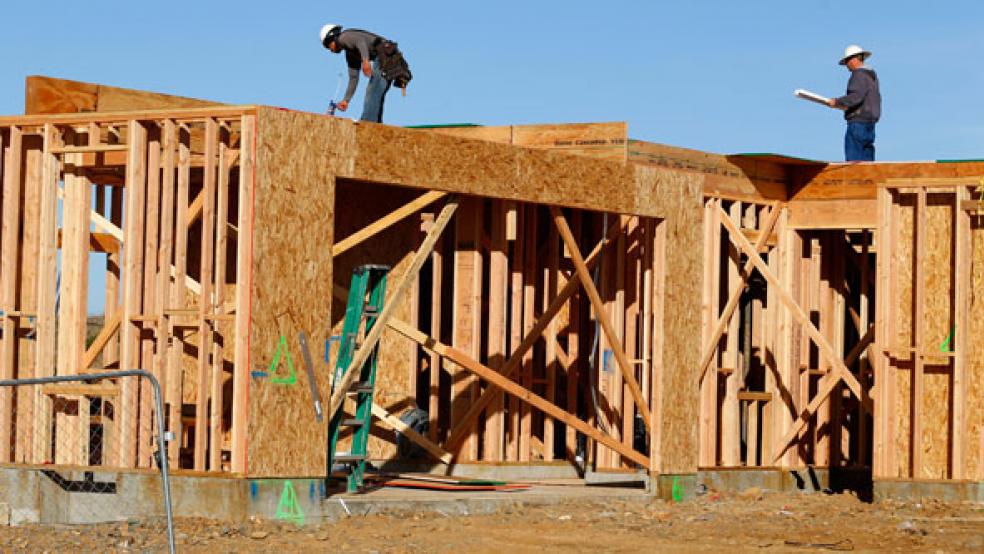The recently-tightened mortgage lending standards have been widely cited for preventing a faster turnaround in the housing market. But the bigger culprit may be the slowdown in construction loans for builders.
Real estate industry experts and home builders have been warning for nearly a year that the lack of new home construction could slow the housing recovery. That moment may be here. The supply of existing homes for sale in December fell to its lowest level in more than 7 years: 4.4 months’ worth of homes are for sale at the current pace, according to data from the National Association of Realtors. That constricted supply, in turn, has driven up prices. December’s average prices nationwide were 11.5 percent higher than a year earlier, according to the NAR.
RELATED: 10 Real Estate Trends to Watch in 2013
That would seem like good news for the market, except that the price increases are starting to scare off buyers. The number of pending home sales fell in December after rising for the past 20 straight months. “The supply limitation appears to be the main factor holding back contract signings in the past month,” said Lawrence Yun, NAR chief economist, in a press release. “Supplies of [new and existing] homes costing less than $100,000 are tight in much of the country, especially in the West, so first-time buyers have fewer options.” First-time home buyers typically make up 35 to 40 percent of the market. In addition, many underwater homeowners are waiting out the market, and for-sale foreclosures are down, falling 23 percent in 2012 as mortgage modifications helped keep many would-be foreclosures off the market.
With prices increasing, conditions would appear ideal for residential contractors to start building. Instead, contractors have completed fewer than 500,000 single-family homes in each of the last three years, according to Bureau figures cited this month in a USA Today report. That’s less than half the number built every year between 1997 and 2003. (The number needs to be between 1.25 and 1.5 million a year just to keep up with population growth, according to Calvin Schnure, an economist at the National Association of Real Estate Investment Trusts.)
The slow pace is a result of banks making relatively few loans for the acquisition and development of land and construction of new homes, known as AD&C financing. The total volume of AD&C loans is one-fifth what it was in 2008 – and that number has stayed the same in the last two years while the rest of the housing market has ticked up, according to data from the Federal Deposit Insurance Corporation compiled by the National Association of Home Builders.
Banks are skittish after having worked to get bad construction loans off their books, says Mark Dotzour, chief economist at Texas A&M’s Real Estate Center. “My impression is that if you’re a homebuilder and you have a client who’s already signed a contract, that’s going to be a fairly easy loan to get from a bank.” But if you’re trying to build 10 spec homes, he says, banks will be more hesitant.
The latest survey of FDIC examiners showed banks tightening up on new home construction loans. The percentage of AD&C portfolios that examiners assessed as high risk dropped from 29 percent in 2010 to 22 percent in 2011, the latest data available. High risk practices include bank funding for projects that have no pre-sale commitments and the funding of loans without considering repayment sources other than collateral.
RELATED: New Mortgage Rules Threaten Minority Home Ownership
Though single-family housing starts in December were 8 percent above those in November that may be because developers who don’t have to rely on bank loans have a corner on the rising market. “If you’re in the publicly traded realm… then you have a distinct advantage right now – you’re the one who can put up spec homes,” Dotzour says. Some of the best-known shareholder-owned firms are companies like Liberty Homes, Ryland Group, and Toll Brothers.
And with banks not lending, Dotzour expects more developers to move toward shareholder financing. He thinks 2013 will see more initial public offerings of such companies’ stock because of the extraordinary market conditions. If so, that will provide some of the capital needed to meet the needs of the growing number of people wanting to buy homes. A report from the consulting firm Deloitte & Touche on key real estate issues in 2013 predicts continued rising demand for single-family homes this year, driven by first-time buyers.
But if capital for builders fails to materialize, last year’s double-digit rise in home values could continue. “With the lack of supply, I think we have a recipe for surprisingly high rates of home price increases this year,” Dotzour says.
That all might seem to be good news for existing homeowners, but price hikes could limit home sales and choke off demand by either convincing potential first-time buyers to sit tight – or make it harder for them to qualify for loans, tamping down the housing recovery.





